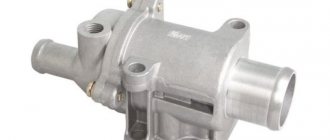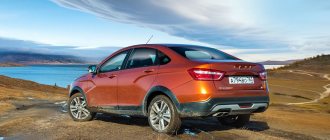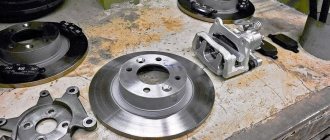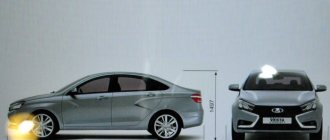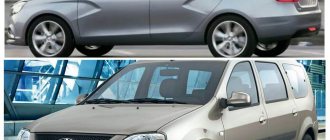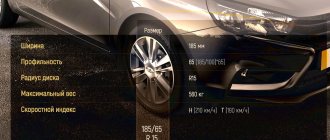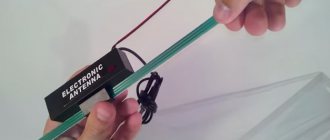- Correction and driving assistance system - description of abs, esc, ebd, hhc Lada Vesta
- Lada Vesta test video:
- How does vesta behave on ice using abs and esp?
- How to disable traction control
- How to disable the traction control system on the Lada Vesta
- How does abs work on west
- What problems can you fix yourself?
- Briefly about the functioning of anti-locking
- Cuvette test Lada vesta with and without esp
- Reliability of TCS on Lada Vesta
- How effective is the abs lada vesta system?
- Operation of the traction control system
- We test the Lada vesta for climbing a hill with the electronic stability control system turned on and off
- Characteristics of traction control system and principle of operation
- Lada vesta electronics are being tested in Lapland
- conclusions
- Test results
- Conclusion
The principle of operation of the antibux
To move a car, grip on the road is important. But its reliability drops significantly if the road is wet or slippery, which increases the likelihood of slipping. It causes problems such as:
- loss of dynamics during acceleration;
- poor handling;
- high probability of skidding;
- increased tire wear.
The directional stability system on the Lada Vesta works in conjunction with traction control system (TCS), which allows the driver to move away on a slippery surface with minimal chance of slipping.
In reality, it looks like this: if the wheel begins to rotate too quickly during acceleration, the traction system is activated and takes corrective measures: braking or reducing the transmitted torque. At the same time, the car remains stable.
On the Lada Vesta, anti-booking works in all trim levels.
3) Rain and snow, slippery roads: when driving uphill
We know that in rainy and snowy weather, the ESP system is excellent at helping drivers keep their car on slippery roads. Thanks to this, we feel more confident behind the wheel in bad weather. And all due to the operation of electronics, which perfectly regulates the stability of the machine even in difficult weather conditions. But if you are driving uphill on wet or slippery roads, it is better to turn off the ESP system. This is necessary so that the car climbs smoothly uphill. Otherwise, the ESP system may, on the contrary, contribute to the car skidding when going uphill.
On our website you will find:
- current information about Lada, new products in production and news related to the brand;
- statistical data on sales and the place of the Russian automobile industry in both the local and international markets;
- useful tips on operation, repair and maintenance of VAZ cars;
- all the most important information that will help you when repairing VAZ cars;
- reviews of the most common problems faced by machines.
If you have any questions regarding the repair of your car, materials and spare parts for it, you can get advice from a specialist. To do this, go to the CONTACTS section and send your question. You will find this and much more about the features of domestic cars on our portal OLADE.RU
What can you check yourself if the ABS light comes on?
The first thing you can do on your own in such a situation is to go to a car wash and ask for a good wash of the rims. Often, this intensive pressure washing can clean the ABS sensors located near the brake discs. On your way to the car wash, you can perform another simple test. Accelerate to a speed of 80-90 kilometers per hour, close the windows and turn off the music. If in this driving mode you hear a slight or annoying hum in the area of the wheels (front or rear), the likely cause of the light is a failure of the wheel bearing. There are several other things you can do:
- inspect the fuse box and replace the module that is responsible for the operation of the anti-lock braking system;
- if possible, read the diagnostic error code and read about it on the forums;
- to a specialist, describing your situation, and then try to correct the error yourself;
- get to the ABS sensors yourself by jacking up the car and removing the wheels to check their cleanliness;
- inspect the electronic control unit located under the hood, check that there is no liquid in it or on it;
- the best solution is to go to a service station and pay for diagnostics of the car's anti-lock braking and electrical systems.
The last step will definitely be the most correct, since you will receive a clear answer to your questions, you will be able to determine the repair budget and the presence of serious problems. This is the only way to completely get rid of problems with the diagnostic system light on and other unusual behavior of the car. It is enough just to connect computer diagnostics with an advanced program and test the car for possible errors. Within a few minutes you will receive the necessary information and can begin to fix the problem yourself or professionally.
ESP indicator
The Vesta ESP (ESC) indicator is installed on the instrument panel. It is possible to disable ESP on Vesta in one click. As a result, the system will not limit the torque on the driving wheels of the car, but will slow down, helping to smoothly enter the turn, preventing the car from slipping into a skid or sliding uncontrollably.
The Lada Vesta ESC can also turn on automatically when you pick up speed or when you turn on the ignition again. Remember that the yellow color of the indicator means that ESP on the Vesta is turned off - the system temporarily stops working.
1) Drift, quick start
If you are a racing driver, like to drift your car, or don't want the stability control system to interfere with your car's handling, you should turn off ESP. Otherwise, the system will prevent you from drifting when the car's wheels begin to lose traction. If you do not turn off ESP, the system will limit wheel slip not only by braking the wheels, but also reduce the transmission of torque to them.
Silence, like in a library
The first impression was very pleasant. What will it be like on the go? I start it up and am amazed - the engine is barely audible. I must say that Vesta’s sound insulation is generally very good (hello, Koreans!). Here, even the protection of the rear arches is piled, so the noise from the wheels and the road is almost inaudible.
It is better not to turn on the audio system only when listening to audiobooks. The sound quality leaves much to be desired, as does the quality of the touch display. The graphics are unclear, the response to clicks is slow, and you have to wait to turn on the camera...
Review of Manufacturer Prices
| Name/article | Price in rubles |
| TB bearing with ABS LADA Vesta432008333R | From 6000 |
| Pads 8450006850 | From 3500 |
| Rear disk 8450031131 on IVS drum | From 1400 |
| Drum size for Lada Vesta 203.2 mm | |
| *prices are as of 04/08/2019 |
Conclusion
You can replace the rear brake element yourself within ten minutes. It is not necessary for a repairman to have special skills, but it is desirable.
The market offers components for the brake system of domestically produced cars. The workmanship is no worse than European analogues, the price is affordable. Service station technicians recommend replacing brake tires in pairs to increase braking efficiency and reduce the risk of an emergency.
How does ABS work on Vesta?
The Lada car manufacturer equips its models with a large number of electronic assistants. Installed systems on Vesta:
- anti-lock brakes – Anti-lock Braking System;
- slip control devices – Traction Control System;
- brake boosters - Brake Assist System and Hydraulic Break Assist;
- rear wheel brake adjustment – Electronic Brake Distribution.
From a safety point of view, an important component of the LADA Vesta is the ABS and EBD electronic systems. Anti-lock system maintains controllability on any road surface. ABS works on Vesta from a speed of more than 8 km/h until the car comes to a complete stop.
Rear brake pads. Photo source: https://www.drive2.ru/l/498725556171309769/
ABS Lada Vesta allows you to avoid skidding in any conditions, even for inexperienced drivers. When braking with ABS, do not release the pedal - periodic pressing increases the time until it comes to a complete stop. It must be taken into account that the braking distance on a slippery or loose surface is significantly longer. On a Lada Vesta with faulty ABS, the hydraulic system continues to operate as usual.
Lada_Vesta_9
In modern Western models, the complex of electronic driver assistants can include more than a dozen or two different systems. B-class budget employees are not yet entitled to such luxury due to their status, but in this area Vesta is ready to give a head start to its competitors. In addition to the usual set of ABS and EBD, VAZ’s new product is already equipped with an exchange rate stability system (ESC) as standard. Over the winter, I managed to study her behavior enough to give her settings the highest rating.
Firstly, it allows you to skid to your heart's content in first gear, allowing you to overcome a difficult section of the yard or an uncleared parking lot. The traction control system is in no hurry to intervene in this case - and it does the right thing. It behaves similarly when starting too quickly from a traffic light on slippery asphalt. I also like this: there is no hysterical help from electronics in situations where it is not required at all.
Secondly, the system does an excellent job of keeping the car on line when cornering. I have driven much more expensive models, where the ESC worked crudely and ingenuously: when drift appeared (we are talking about front-wheel drive), it simply “turned off” the gas pedal and then operated the brakes at its discretion. In particular, the products of the Peugeot Citroen alliance, including the Citroen C5, were guilty of this. It is a very unpleasant phenomenon when suddenly, in an emergency situation, a car deliberately deprives the driver of the ability to control the behavior of the vehicle. The right pedal was “turned on” only after a complete return to the trajectory.
Vesta does not limit you in anything and at the same time remains extremely obedient. Moreover, in response to outright provocation - pressing the accelerator when drift has already begun - the car somehow magically not only accelerates, but also “turns” its stern. Like all-wheel drive! The first time I attributed it to my own wrong feelings. But subsequent experiments (of course, not on public roads) confirmed the correctness of the impressions.
Thirdly, ESC on Vesta is disabled. If the intelligence of electronics is not enough, then a button on the center console is at your service. I used it a couple of times, also as an experiment. Even with the activated stabilization system, Vesta rows well in deep snow, but without it there is more confidence. By the way, AVTOVAZ listened to the opinion of journalists and potential buyers and, according to rumors, is going to introduce an “ESC OFF” button on the high Xray hatchback.
I note that over the past snowy winter the stabilization system never worked unexpectedly for me. I attribute this to good winter tires and the right choice of speed. But in safe places I experimented with it to my heart’s content.
What do you think, should ESC be made mandatory equipment for inexpensive models? Is there any real benefit from it, in your opinion, or is it just another way to rip off more money from the buyer?
Well, let's go!
Vesta almost didn’t notice the asphalt joints, but on the snow frozen in mounds it seemed a little harsh, however, no breakdowns were observed. The hard plastic began to rattle over bumps, although not as much as some competitors. It is better to press the brake smoothly and in advance; if you press the pedal a little harder, ABS will intervene, which is sometimes out of place, and the braking distance increases by a couple of meters.
I drive out onto a cleared road and am surprised at how composed the car behaves at high speed. In terms of handling, Vesta was reminiscent of younger VAGs. She reacted sharply to steering movements and only returned to zero reluctantly.
What it really lacked was dynamics. When overtaking, I wanted to go out and push. Perhaps the 1.8 drives better, but the 1.6 is definitely not for the highway, and the gearbox is tuned for the city. The gears are short, most likely to save fuel. Therefore, already at 60 you can safely stick in the fifth. The car pulls calmly, but changing gears is not very convenient. The travel of the gearshift lever, as well as the clutch pedal, is long.
You can drive over large uneven surfaces without fear of tearing off the bumper. The ground clearance here feels like a regular SUV - 178 mm, which Vesta does not pretend to achieve at all. For this purpose there is a raised version of Cross. But this is the only way our car could cope with a gravel road or crossing a curb.
Test results
Let's summarize how the Lada Vesta test went. We tried to make a new generation Russian car. Did it work or not? Everyone is waiting for the verdict, the sentence. These are no longer the buckets of bolts that were there before. Yes, it worked. Lada Vesta has three main advantages. The first is appearance. She turned out beautiful. Secondly, it is agility, excitement, agility. The third plus is that the Lada Vesta is large and spacious.
It has big doors, it doesn't feel like a "B" class. When you get into a small car, you feel discriminated against, small. And here you are driving next to the Focuses, with the Camry. Yes, they are a little wider, but we are not inferior in length, beauty, and maneuverability. This particular configuration has comfortable luxury seats. What about the cons? This is a weak engine, low maximum speed.
Interior build quality is not very good. The third main disadvantage is the lack of a full automatic transmission. It was made as a competitor to Solaris. But, most Solaris are sold with an automatic transmission. Therefore, while Vesta does not compete, the box is not the same. This car is for those who have driven VAZs all their lives.
You pay a little more than for a Priora and get a car of a completely different level. It is more comfortable, quieter, more maneuverable, larger, more beautiful, more prestigious. People on Kruzaks turn and look what it is.
Stability Control The vehicle's active safety features electronics that help prevent an accident. Lada Vesta is equipped with many assistants that help maintain vehicle controllability when traveling. Among other things, the driver should know how the traction control system of the Lada Vesta works.
DIY Lada repair
Not everyone has the opportunity to seek help from specialized places as a result of every breakdown, because most of the problems can be fixed on their own. VAZ repair has a distinctive feature - the user in most cases pays more money for the work than for parts and spare parts, because it is no secret that the equipment for domestic cars is much cheaper than for foreign cars. So why overpay? So that you can repair the VAZ yourself, we have developed a number of instructions that are aimed at the average user, and not at a professional. You can get acquainted with the recommendations in video format on our YouTube channel - OLADE. After studying the materials and videos, you will learn everything about the Lada that is necessary to carry out repair work and resolve problematic issues. An experienced car owner should “feel” his car and understand the principle of its structure from the inside . Our website is designed to help you understand this matter, always keep abreast of the latest AvtoVAZ news, and also save significantly on the maintenance and repair of your vehicle. Our specialists are always ready to provide advice on all issues of interest.
Other causes of car knocking
The stabilizer link is not the only cause of knocking noises in a vehicle. If you think about it, you can find a lot of them on the Lada Vesta. And often the stabilizer struts have nothing to do with them.
As soon as the stabilizer struts are replaced, extraneous noise in the car's interior will disappear, and driving will become safe and comfortable. For car service technicians, such a replacement is a simple task, but an ordinary car enthusiast can do similar work.
In fact, nonsense malfunctions. What happens, for example, even if the strut pin falls out? If the car did not “turn on the Camel Trophy” at that moment, then, I think, this will not lead to flying off the track.
And if I, say, drive less than 10,000 a year and don’t drive around the north and Kazakhstan, these racks wouldn’t start knocking soon enough.
After all, who was the first place they knocked? Test-tormentors Droma, Wheels and others.
Another thing is that the plant and dealers should react faster, and not make people wait weeks for spare parts.
And with the Glushak pillow there is also a very interesting point.
Sources
- https://vestaxray.ru/remont/lada-vesta-stuki-v-perednej-podveske.html
- https://expertvaz.ru/lada-vesta/stojki-stabilizatora.html
- https://www.kolesa.ru/lada/naslazhdajsja-tishinoj-menjaem-stojki-stabilizatora-na-redakcionnoj-lada-vesta-2016-04-03
Reliability of TCS on Lada Vesta
Each vehicle stabilization system was tested under different road surface conditions (wet asphalt, slush, ice, etc.). The TCS traction control system has shown its best side: it “intervenes” only when necessary and works well with other electronics.
The owners are also mostly satisfied, although some took time to adapt to all the functionality of Vesta.
It’s better to think several times before turning off the TCS. Electronic safety systems, including Lada Vesta anti-skid, increase your chances of a successful outcome of a dangerous situation on the road. And even under normal driving conditions, you can feel more confident knowing that there is such a safety net.
Characteristics of traction control system and principle of operation
Receiving a signal from indicators mounted on the wheels, the TCS traction control system monitors the rotation speed of the discs using a built-in electronic unit. If there is a sharp increase in the speed of rotation of one of the wheels, the TCS does everything possible to reduce traction and establish a stable balance. At the same time, the braking function operates due to electro-hydraulic actuators.
On the Lada Vesta, the anti-box works as follows:
- the option is indispensable on wet road surfaces and in other circumstances resulting in insufficient grip;
- using data received from sensors, the stabilization system knows about the speed of the torque and adjusts the indicators through the electronic system in a timely manner;
- anti-skid Lada Vesta significantly increases the level of balance when entering a turn;
- The anti-skid starts to work in high gears, and not all owners like the inappropriate assistance during a sharp start.
Most modern models have the function of turning off this road assistant. However, experts strongly restrict owners from such a decision, since the option significantly increases the chances of staying on the road surface and not flying off it. It makes no sense to disable the Lada Vesta APS.
Alternative names
Most often, the abbreviation ASR is found in different materials.
But this is far from the only name for traction control. This is due to the fact that each auto company strives to highlight its product, and therefore calls almost identical developments by different names.
In particular, you can find the following options:
- Mercedes, Audi and Volkswagen have ASR;
- the Bavarians from BMW use the concept of ASC;
- on Toyota cars it is TRC or A-TRAC;
- on Opel cars you will see the DSA icon;
- for elite crossovers Range Rover ETC;
- Swedish Volvos have the abbreviation STC;
- The Japanese from Honda use the concept of TCS.
But the most important thing here is that the name does not change the essence. The design and principle of operation are almost identical everywhere, but with their own small nuances that do not globally affect the operation of the system.
Design Features
Initially, engine 21129 retained the design of the basic version 21127:
- “tall” gray cylinder block, transferred from 11183, the surfaces of the liners are processed by honing;
- Cylinder head from modification 21124;
- gas distribution mechanism with phased injection with hydraulic compensation of thermal valve clearance;
- lightweight piston group from Federal Mogul;
- V-belt drive of timing camshafts with rounded teeth from Gates with a service life of 200,000 km;
- crankshaft with long radius crank from internal combustion engine 11183;
- fuel rail with medium-performance injectors from Bosch or Siemens;
- individual spark plug ignition coils without a high-voltage wire bundle;
- increased diameter of the damper on the flywheel;
- catalytic converter built into the exhaust tract - catalytic collector.
Operation of the traction control system
Each wheel has sensors that read wheel revolutions. As soon as the computer realizes that one of the front wheels is spinning too quickly, the throttle valve closes and the traction is dampened. When the wheel speed is equalized, the damper opens. This system can be disabled. Press the button, hold it for a while, and the shutdown icon appears. There is an emergency braking assistance system.
On old basins, if you press the gas, then even if there is ABS, it works. Here at Vesta there is a system where each wheel brakes with the same force. This is control of the braking force on each wheel. Plus, there is an assistant for extreme braking. If you press the pedal hard, you don't need to press hard. The car brakes evenly, even if the surface is not the same.
How much does Lada Vesta cost?
The better Solaris
Because he is not Russian. There are people who fundamentally do not like Russian things. So, there is nothing typically Tazovod about the Lada Vesta anymore. Motor Priorovsky, 106 l. With. It has Euro-5 standards. What does this give? He doesn't react immediately. There is also a stabilization system that performs the function of trajectory control. Each wheel has a sensor that reads wheel revolutions. If you know the revolutions of each wheel, you can understand which trajectory the car is moving. You turn the steering wheel. The outer wheel begins to spin faster than the inner one.
The machine understands this. As soon as the front wheels begin to slide, the car itself cuts off the gas for you and aligns the trajectory to a smoother one. It helps you control the car in a critical situation. This will not save you from severe ice. But, if you get carried away on a wet road, this can save you.
Lada Vesta has a comfortable armrest. There are people who criticize this armrest. They were given a car to drive for 20 minutes, they didn’t understand it, and they scolded this armrest. How does he work? To fold it back, you simply fold it back. When you lower it, it goes to its lowest position. This is not very convenient. It can be raised by one or more clicks.
When to turn off ESP
Typically, the domestic analogue of ESP - ESC on Vesta works constantly. It is recommended to disable it to return manual control over the vehicle’s maneuverability and speed in the following cases:
- when driving uphill on a snowy road;
- off-road after heavy rains;
- during a long climb;
- when driving at high speed;
- when participating in amateur racing on equipped tracks;
- during difficult maneuvering;
- if necessary, carry out a quick start and speed up;
- on sections of the road with sand or fine gravel.
Remember that turning off the ESP on the Vesta “Cross” sedan will provoke an increase in the percentage of driver “work” with the steering wheel and gas on turns and steep descents and ascents.
conclusions
Despite the shorter braking distance, disabling ABS on the Lada Vesta is not recommended. The new systems work differently than earlier versions, when they did not control the rear axle when disabled. The car could somehow remain in a stable position.
In the current version, when ABS is turned off, the cylinder evenly distributes braking forces between all four wheels. When you press the brake pedal hard, all the wheels lock and the car becomes completely out of control. Skidding is guaranteed.
Lada Vesta has quite decent dynamic characteristics. But, they describe the state of affairs on a good, dry road surface. What happens to the speed gain if the car ends up on a snowy or icy road?
Necessity
Replacement of the rear brake pads of the Lada Vesta should be carried out when either the linings or the drum of the entire mechanism are worn out. In addition, work is carried out in case of damage to the linings - the appearance of deep grooves on them, oiling, as well as cases of material peeling off from the base.
IMPORTANT! Replacement is carried out as a whole set. It is strictly prohibited to carry out work on only one wheel! This can cause the car to skid during braking. Even if there are problems with the pads on one of the wheels, a new set is still installed.
Briefly about the functioning of anti-locking
Cars equipped with ABS do not lose control during any type of braking. Anti-skid system components:
- control device;
- speed sensors for each wheel;
- hydraulic pressure control unit in the brake line.
The ABS unit on Vesta receives a signal from the rotation sensors of each wheel. Based on this data, the processor issues commands to the hydraulic unit of the brake system. Until the car comes to a complete stop, directional stability is maintained, even if the driver tries to press the pedal all the way.
Test No. 2: Passing an ice track
The tests took place on an ice track about 700 meters long. We drove around the circle with the electronic assistants working, and then without them (the fuse was removed). The results are presented in the table:
| Trial | With ESC, TCS, ABS and EBD | Without ESC, TCS, ABS and EBD |
| Passing a lap (ice) | 1 min 26 sec | 1 min 34 sec |
Conclusion : You might think that without ESC the lap will be steeper and more fun, but in fact, the driver is fighting with the car throughout the entire track. There are no worries with electronics, the main thing is to choose the right speed when entering a turn. If the speed is too high, the electronics will not help and the car will fly off the track.
HHC function
Prevents the car from rolling away when starting on an incline. When stopping on an incline greater than 4%, depress the brake pedal with sufficient force to keep the vehicle stationary. When you subsequently release the brake pedal and press the accelerator pedal, the HHC function maintains hydraulic pressure in the brakes until the vehicle starts, but for no more than 2 seconds, which prevents the vehicle from rolling away.
The operation of the HHC is accompanied by a characteristic noise of the actuators. HHC does not operate when the parking brake is applied, the driver's door is open, or the ESC malfunctions.
Disabling the ESC system
ESC disable button If the dynamic stabilization system “interferes” with the driver when driving the car, it can be turned off. Usually there is a special button on the dashboard for these purposes. It is recommended to disable ESC in the following cases:
- when using a small spare wheel (dokatka);
- when using wheels of different diameters;
- when driving on grass, patchy ice, off-road, sand;
- when driving with snow chains;
- while rocking a car that is stuck in snow/mud;
- when testing a machine on a dynamic stand.
2) Driving on sand or mud
When going outdoors or driving through mud, we advise you to also turn off the ESP system so that the electronics do not brake some wheels that begin to slip on a road that runs through rough terrain. Also, off-road driving requires power, which will be limited by the dynamic stabilization system, as a result of which the car may get stuck. If you are already stuck, then you also need to turn off ESP, as it will prevent you from leaving.


